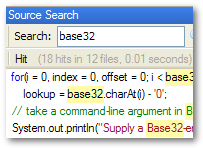I’m really pleased to announce Entrian Source Search 1.6.3, which adds significant flexibility to the way you use Source Search:
- Move, delete, and rename indexes.
- Open multiple indexes at the same time.
- Share indexes on the network.
- Specify the location of new indexes.
- A command-line tool for searching and indexing.
The Manage Indexes dialog

The Manage Indexes dialog adds a pile of features for index management:
- Moving indexes from one place to another (eg. from one drive to another).
- Deleting old indexes.
- Recreating corrupt indexes.
- Creating secondary indexes that aren’t tied to a solution.
Secondary indexes
1.6.3 also introduces the idea of a “secondary index” – each solution gets (or shares) a primary index as before, but you can open several secondary indexes as well. These are really useful for library code – for instance, Source Search is built using Lucene.NET; sometimes I want to include the Lucene sources in my searches, and sometimes not. I can build a secondary index for Lucene, and only open it when I want to.
Read-only indexes
Often library code doesn’t change, so secondary indexes can be read-only – you don’t need to waste your PC’s time scanning for changes if you don’t want to, because you can open secondary indexes read-only.
Networked indexes
Taking the idea of a secondary index even further, they can live on a network drive. Some organisations keep library code on a network drive, and Source Search now supports this. One network server maintains the index for the shared code, updating it in real time if it changes, and all the developers open that index as a read-only secondary index.
Command line tool: ess.exe
You can now drive Source Search from the command line:
- Create an index, specifying the root directories, inclusions, exclusions, etc.
- Update an index to pick up changes to the code (the command-line tool doesn’t watch the filesystem; it’s more for batch operation).
- Search one or more indexes.

It’s early days for ess.exe – there’s lots it could do but can’t do yet. Let me know what you want from it!
As always, this new release is available from the download page or the gallery.




